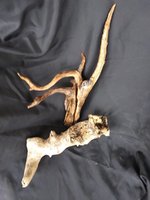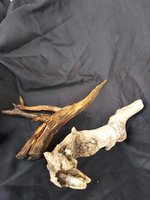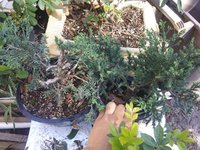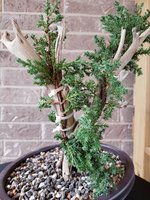SU2
Omono
So I've got 2 pieces of really cool deadwood, quite sure they were previously owned&used by some kind of caged bird, at any rate they're incredibly durable timber and once it crossed my mind (tanuki) it wouldn't leave, so I've got 2 pieces of this cool wood (IE, will be making 2 specimen), I've already begun 'basic carving' on one of them, as seen in this pic of the wood:


I know I've gotta carve a good deal more (right?) before "proper placement" of my living scion here, thankfully I've got all the grinding equipment I could want for such things (NOTE: I see these pieces of wood as almost positively being too-large for any "final designs" I have in-mind, however, like with most of my [real]deadwood I'm of the mindset that "more = better" since it's "a canvas" I'll carve and grind to-shape later once the final design is becoming more visible!)
In addition to confirming "I should cut-into them wayyy more, to 'contour' the scions that'll go into them", I was hesitant Re species.... I have two in-mind here:
#1 - Juniper: I have a pair of ~2yr old, Walmart $5 Juniper parsoni or procumbens that's "got the limbs" for me to fit it "over" the deadwood well enough, and then it's just a long waiting game (right?)

#2 - Ficus Microcarpa! No point in taking pictures because I simply have too many, I always stick (propagate) the cuttings when pruning my (sole) bonsai-ficus.M so it's basically a ficus-factory here, I have dozens in all size ranges from 1mm to 1" thickness. I figure that I'd use >1 actual ficus tree when making this one, since the roots & trunk-bases can "wrap&fuse" with each other & the tanuki-wood (in fact I do this routinely with rocks for root-over-rock, anytime I find a cool rock to use I plant several Ficus M's upon it )
)
There's also Live Oak & Laurel Oak as options, I have many dozens of those (seedling stages to ~1/8").
Am dead-set on using either 1 or both of the Junipers on one of my pieces of driftwood -- would LOVE suggestions on which piece of driftwood to use with the Juniper(s)*, and which to leave for (ficus-or-oak) seedlings!!
Thanks a ton for any advice, and apologies if this is considered VERY or "too" kitsch for the forum, am a tropical grower am not trying to trick a judge with some black pine am just trying to make something neat, with these materials that I have & know I can "wrap around" the wood ('wrapping' is pretty easy here in FL!)


I know I've gotta carve a good deal more (right?) before "proper placement" of my living scion here, thankfully I've got all the grinding equipment I could want for such things (NOTE: I see these pieces of wood as almost positively being too-large for any "final designs" I have in-mind, however, like with most of my [real]deadwood I'm of the mindset that "more = better" since it's "a canvas" I'll carve and grind to-shape later once the final design is becoming more visible!)
In addition to confirming "I should cut-into them wayyy more, to 'contour' the scions that'll go into them", I was hesitant Re species.... I have two in-mind here:
#1 - Juniper: I have a pair of ~2yr old, Walmart $5 Juniper parsoni or procumbens that's "got the limbs" for me to fit it "over" the deadwood well enough, and then it's just a long waiting game (right?)

#2 - Ficus Microcarpa! No point in taking pictures because I simply have too many, I always stick (propagate) the cuttings when pruning my (sole) bonsai-ficus.M so it's basically a ficus-factory here, I have dozens in all size ranges from 1mm to 1" thickness. I figure that I'd use >1 actual ficus tree when making this one, since the roots & trunk-bases can "wrap&fuse" with each other & the tanuki-wood (in fact I do this routinely with rocks for root-over-rock, anytime I find a cool rock to use I plant several Ficus M's upon it
There's also Live Oak & Laurel Oak as options, I have many dozens of those (seedling stages to ~1/8").
Am dead-set on using either 1 or both of the Junipers on one of my pieces of driftwood -- would LOVE suggestions on which piece of driftwood to use with the Juniper(s)*, and which to leave for (ficus-or-oak) seedlings!!
Thanks a ton for any advice, and apologies if this is considered VERY or "too" kitsch for the forum, am a tropical grower am not trying to trick a judge with some black pine am just trying to make something neat, with these materials that I have & know I can "wrap around" the wood ('wrapping' is pretty easy here in FL!)





